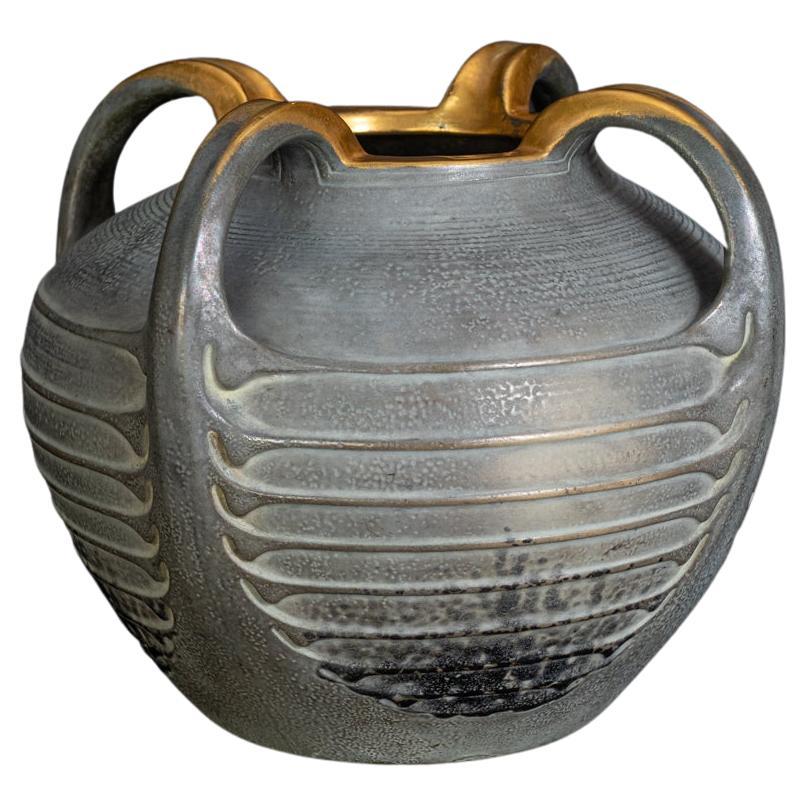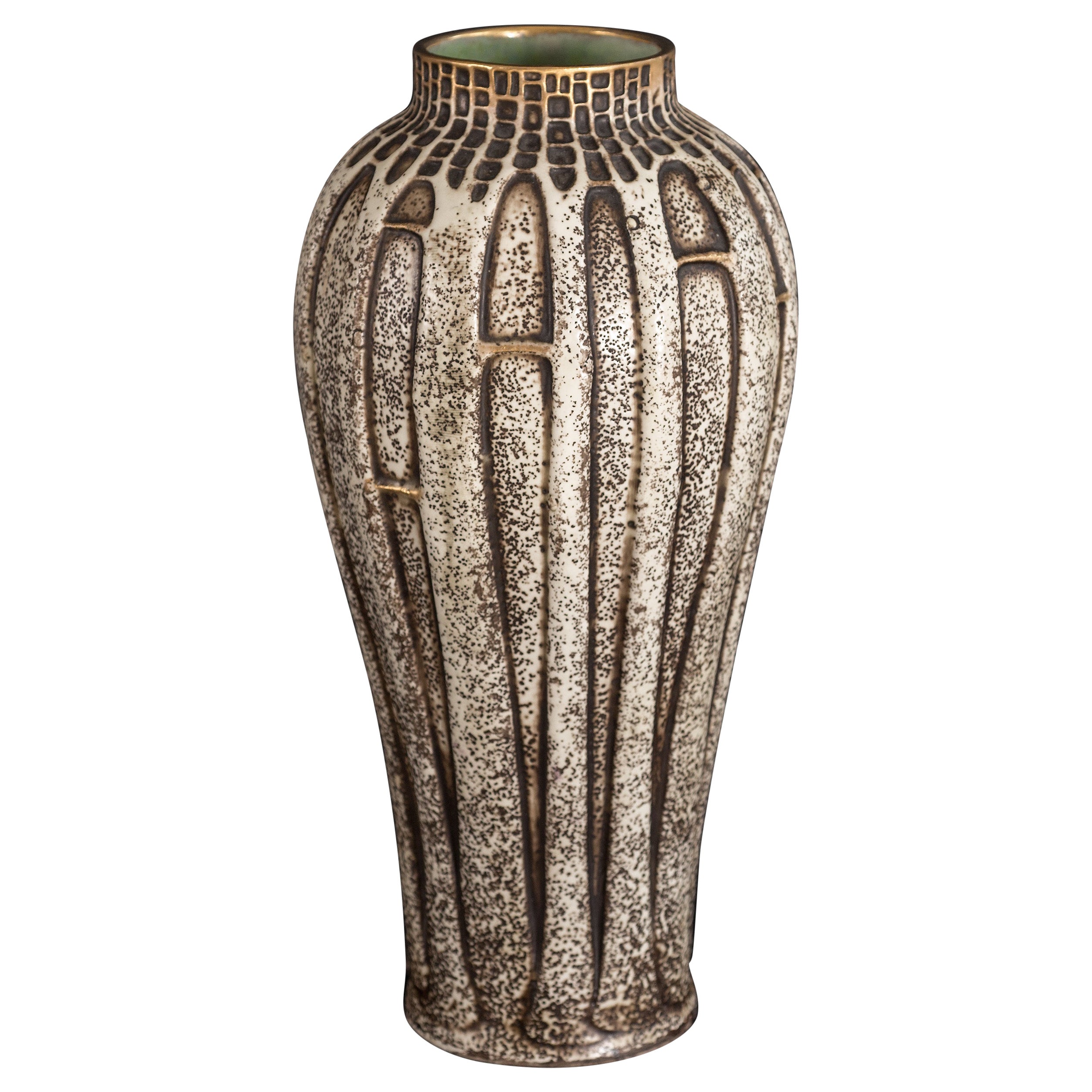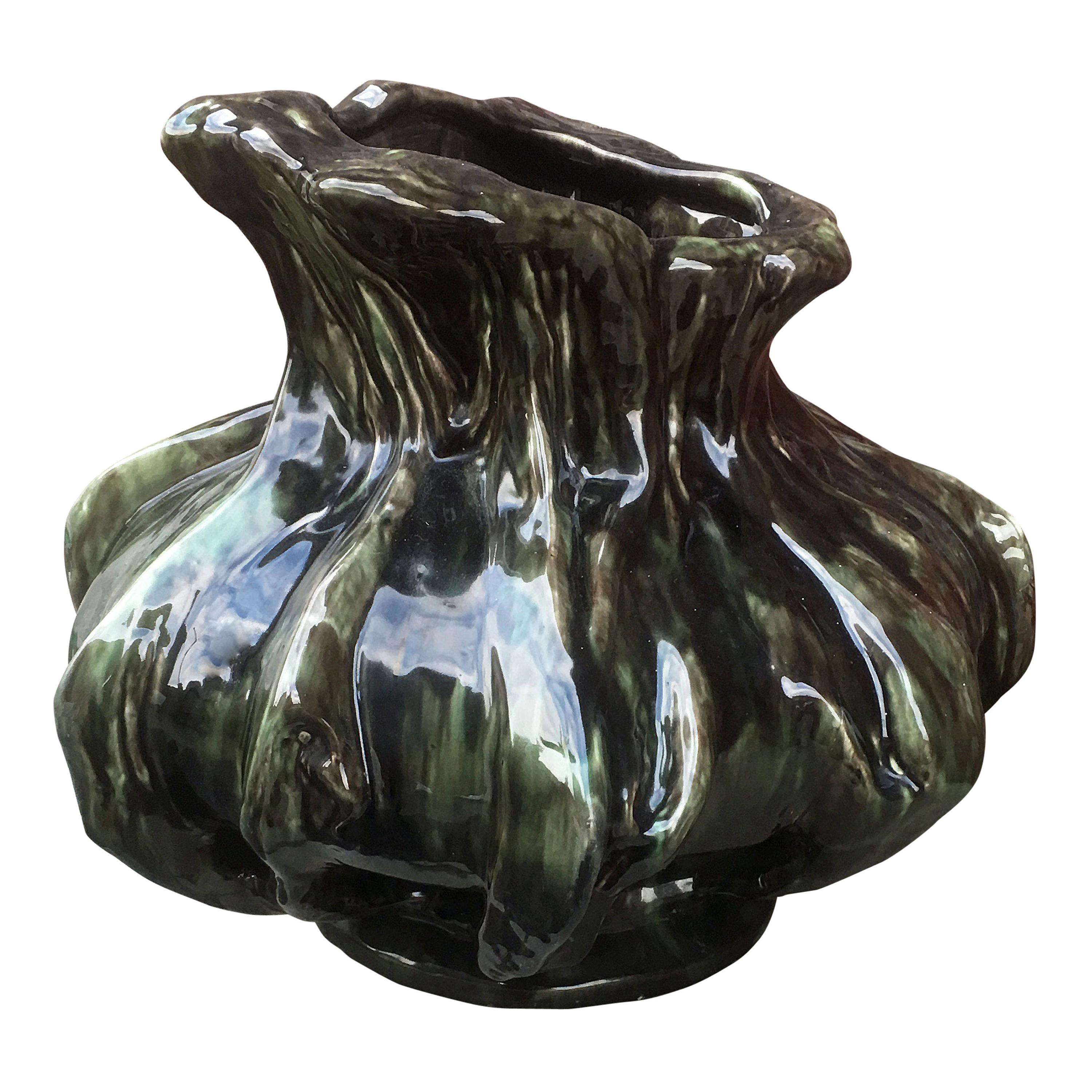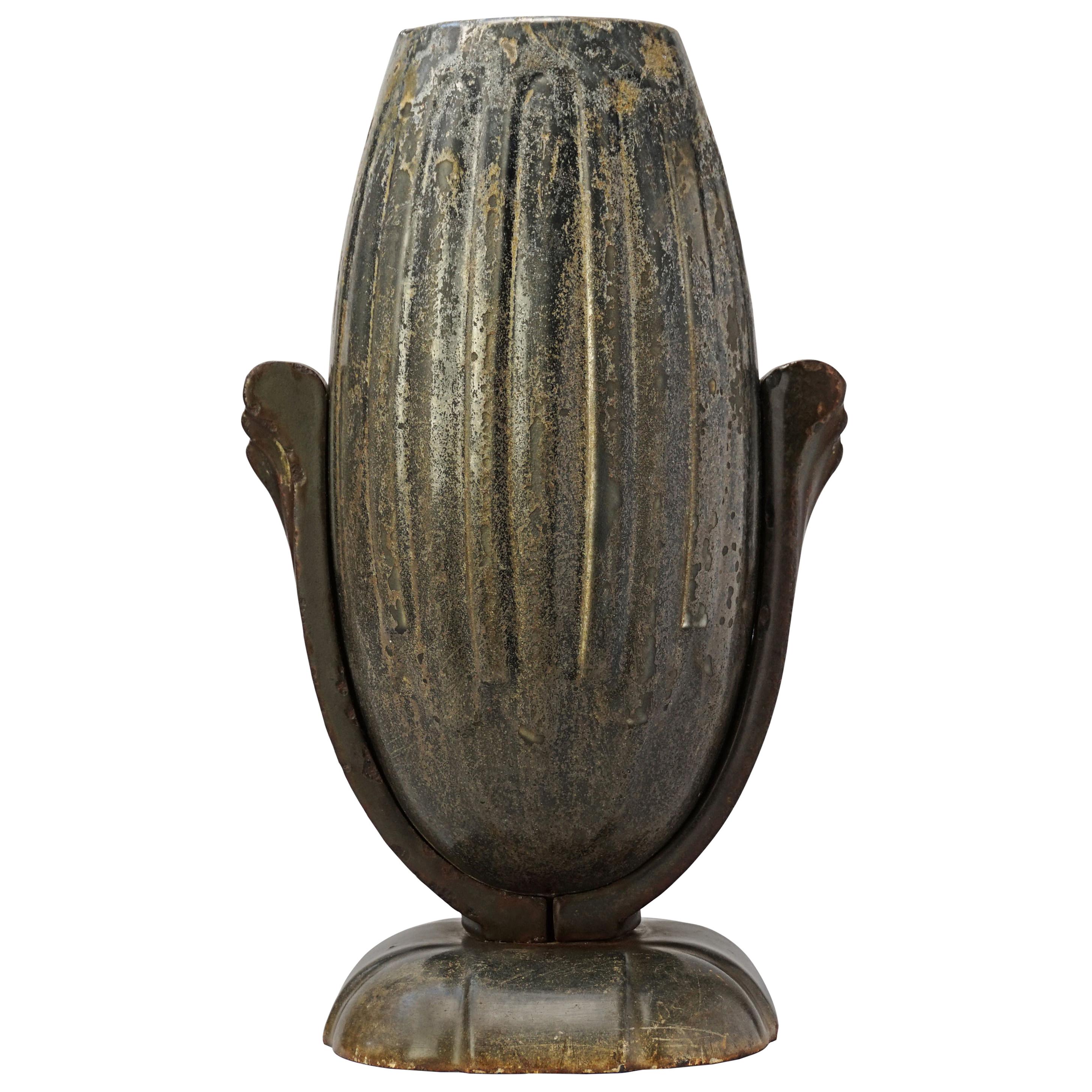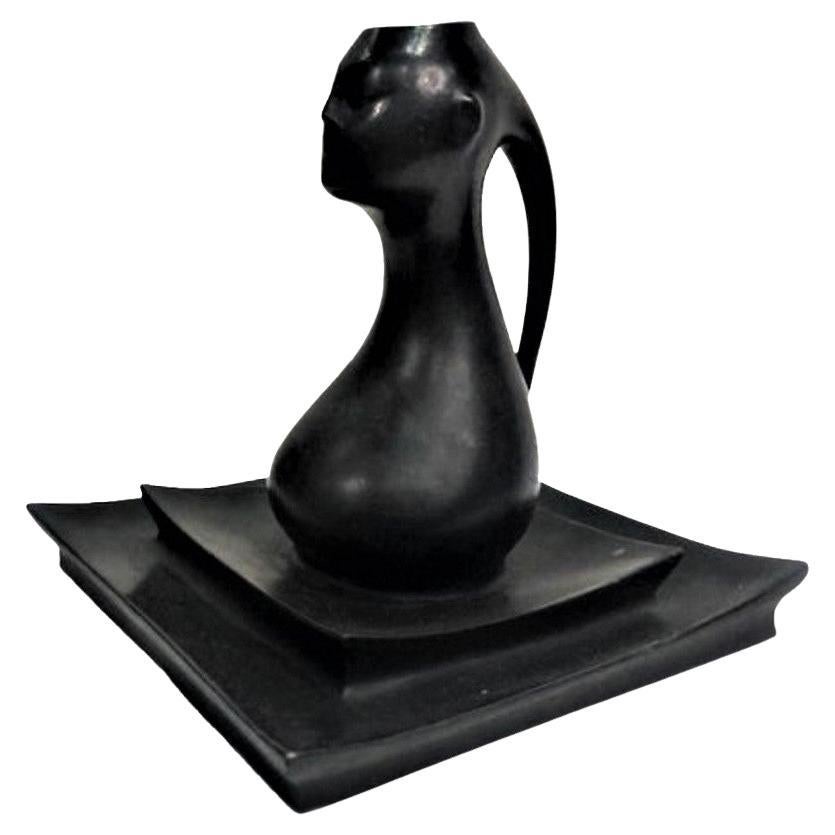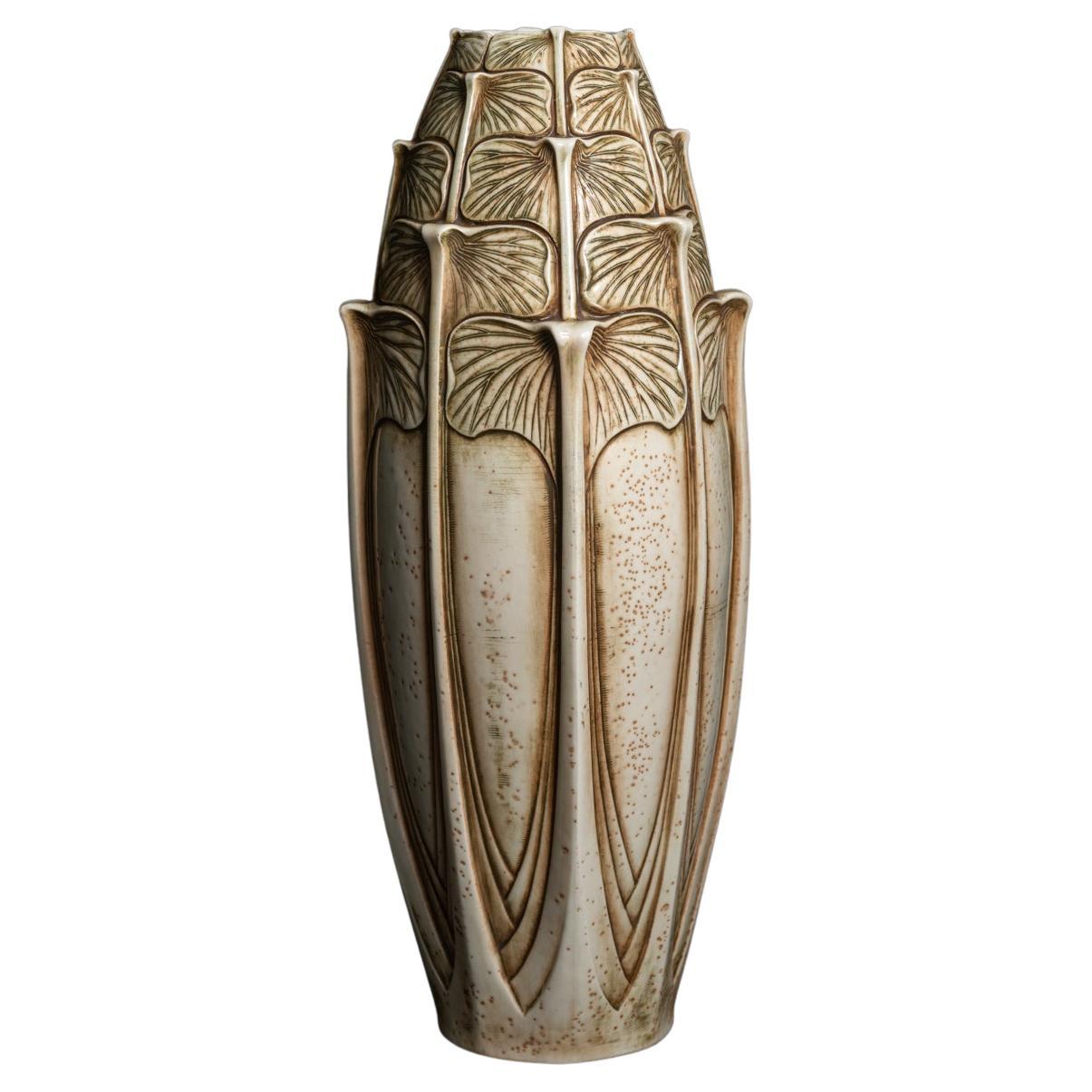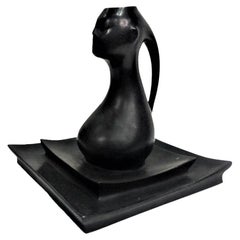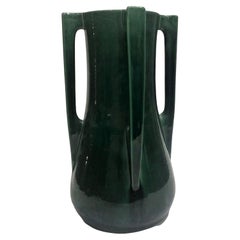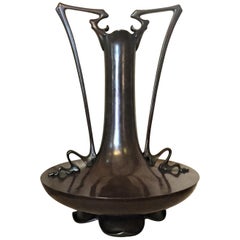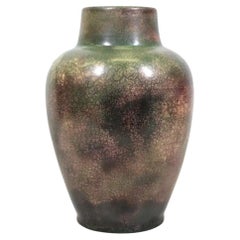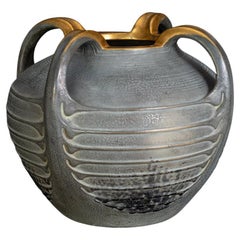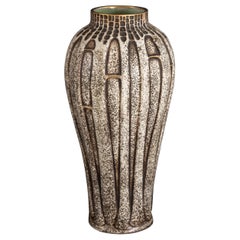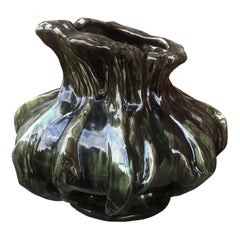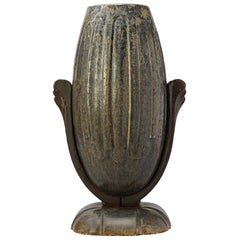Items Similar to Paul Dachsel for Turn Teplitz, Austrian Jugenstil Ceramic ‘Fern’ Vase, ca. 1900
Want more images or videos?
Request additional images or videos from the seller
1 of 9
Paul Dachsel for Turn Teplitz, Austrian Jugenstil Ceramic ‘Fern’ Vase, ca. 1900
$1,600
£1,208.49
€1,396.66
CA$2,244.24
A$2,496.18
CHF 1,306.45
MX$30,445.12
NOK 16,415.96
SEK 15,441.33
DKK 10,424.73
About the Item
DETAILS:
Fully marked on bottom.
DIMENSIONS:
height: 6.75 inches, width: 4.5 inches, depth: 4.5 inches
ABOUT THE ARTIST
Paul Dachsel (Czech, born circa 1880) was the son-in-law of Alfred Stellmacher, the founder of Amphora Pottery company in Turn-Teplitz, then in Austria. Very little is known or was written about Dachsel. He served as a designer at Amphora from 1893 until 1905. There, he was instrumental in creating new motifs and designs inspired by the voluptuous, organic Art Nouveau style, as well as incorporating Japanese shapes, such as the sake bottle, to a traditional Victorian vase body. Very soon, most of the vases had converted to Art Nouveau in shape and decoration. In 1905, Dachsel founded his own pottery studio, Kunstkeramik Paul Dachsel. He continued to draw inspiration from Art Nouveau and created designs that favored simple forms elaborated with applied handles, rims, and ornaments. In many examples, he favored tertiary colors and folded, flat, and soft-edged shapes, giving his work a fairy-tale quality. Dachsel’s ceramic studio remained in business until 1911.
- Creator:Paul Dachsel (Maker)
- Dimensions:Height: 6.75 in (17.15 cm)Width: 4.5 in (11.43 cm)Depth: 4.5 in (11.43 cm)
- Style:Art Nouveau (Of the Period)
- Materials and Techniques:
- Place of Origin:
- Period:1900-1909
- Date of Manufacture:circa 1900
- Condition:Wear consistent with age and use. We make our best effort to provide a fair and descriptive condition report. Please examine photos attentively, as they are an integral part of the description. Send us a message to request more details or discuss price.
- Seller Location:New York, NY
- Reference Number:1stDibs: LU2819330230792
About the Seller
5.0
Gold Seller
Premium sellers maintaining a 4.3+ rating and 24-hour response times
Established in 1993
1stDibs seller since 2017
84 sales on 1stDibs
Typical response time: 8 hours
- ShippingRetrieving quote...Shipping from: New York, NY
- Return Policy
Authenticity Guarantee
In the unlikely event there’s an issue with an item’s authenticity, contact us within 1 year for a full refund. DetailsMoney-Back Guarantee
If your item is not as described, is damaged in transit, or does not arrive, contact us within 7 days for a full refund. Details24-Hour Cancellation
You have a 24-hour grace period in which to reconsider your purchase, with no questions asked.Vetted Professional Sellers
Our world-class sellers must adhere to strict standards for service and quality, maintaining the integrity of our listings.Price-Match Guarantee
If you find that a seller listed the same item for a lower price elsewhere, we’ll match it.Trusted Global Delivery
Our best-in-class carrier network provides specialized shipping options worldwide, including custom delivery.More From This Seller
View AllAlfonso Canciani, Viennese Secession Orientalist Bronze Vase, c. 1910
By Alfonso Canciani
Located in New York, NY
Alfonso Canciani (Italian-Austrian, 1863-1955) was a famous Italian-Austrian sculptor of the period of accession to the Viennese Secession. Son of a stonemason, after a realist period he managed to establish himself as a leading sculptor of the Viennese Secession. In fact, he worked in Vienna, where he had enrolled in 1886 at the Academy of Fine Arts, then at the Higher School of Sculpture and finally at the Special School, where he obtained the Rome prize for the sketch for Dante's Monument.
He developed a notable business obtaining important prizes and numerous commissions. First among the sculptors of the Viennese capital, he was invited to join the Association of the Viennese Secession, of which Klimt was magna pars, after the exhibition of Dante's group in 1900 at the Secession exhibition, and obtained the most important Austrian artistic prize, the Kunstlerlpreis.
This same work, presented in 1910 in Berlin, at the Great Art Exhibition, also received an important recognition here. He obtained the Rome prize in 1896, exhibited successfully in Munich and in 1899 at the III International Art Exhibition in Venice.
In that period he made some statues of saints for the cathedral of Santo Stefano in Vienna, the monument to Wagner, the bust of Nietzsche for the University, the scepter and the gold chain of the University Rector, figures of Italian poets ( Petrarch, Boccaccio, Tasso, Ariosto).
He submitted a sketch for the official monument to Empress Elizabeth, which was then built in Austrisn Gföhl and Pula. At the time of his accession to the Secession, he dedicated himself to decorating the facade of the Artaria house in Vienna in collaboration with the architect Max Fabiani.
He later abandoned the symbolist decorativism of the Jugendstil for a more concentrated and vigorous style, approaching the Belgian sculptor Constantin Meunier for the theme of work, and preferring to exhibit at the Künstlerhaus.
In Vienna, he was generous with advice and help with the Italians and in particular with his fellow citizens (such as the Brazzanese Luigi Visintin, then a university student).
After the First World War, he returned to Italy and lived in Friuli, penalized by the fact that the Habsburg Empire had by now disappeared. Instead of large-scale public monuments, he then devoted himself to engraving medals (e.g. for Benedict XV and for the Italian mission in Vienna in 1919) and to designing funeral monuments (examples in Mali Lošinj and Trieste) and portrait busts (of Generals Carlo Caneva and Antonio Baldissera in Udine, sculptures of the War Memorial of Corno di Rosazzo). After all, he had already executed the Bab grave monument in the Döblinger cemetery in Vienna in 1909.
He taught in Trieste from 1920 until 1935, at the local school of industrial art, where he had Marcello Mascherini...
Category
Vintage 1910s Austrian Jugendstil Vases
Materials
Bronze
Japanese Art Nouveau, Awaji Ware Art Studio Pottery Flower Vase, Ca. 1900
By Awaji Pottery
Located in New York, NY
DIMENSIONS:
Height: 12.5 inches
Width: 6.75 inches
Depth: 6.75 inches
ABOUT AWAJI POTTERY
Awaji pottery was made on the Japanese island of the same name between 1830 and 19...
Category
Antique Early 1900s Japanese Art Nouveau Vases
Materials
Ceramic
Japanese Art Nouveau Meiji Period Patinated Bronze Vase, circa 1900
Located in New York, NY
Although unmarked, this rare and important, grand but at the same exquisite patinated bronze vase has just a very few little details, defying the shape of the handles, as well as the...
Category
Antique Early 1900s Japanese Art Nouveau Vases
Materials
Bronze
Arts & Crafts Chinese-Form Ceramic Vase, ca. 1900
By Roseville Pottery
Located in New York, NY
American Arts & Crafts
Chinese-Form Pauleo Pattern Glazed Ceramic Vase
In Manner of Roseville for Tiffany
Circa 1900
DIMENSIONS
Height: 15.75 inches (40.01 cm)
Diameter: 10.5 inch...
Category
Antique Early 1900s American Art Nouveau Vases
Materials
Ceramic
Japanese Art Nouveau Awaji Ware Art Studio Pottery Flower Vase, ca. 1900s
Located in New York, NY
Japanese Art Nouveau
Flower Vase
Awaji Ware Art Studio Pottery
ca. 1900s
ABOUT AWAJI WARE ART STUDIO POTTERY
Awaji pottery was made on the Japanese island of the same name between...
Category
Antique Early 1900s Japanese Art Nouveau Vases
Materials
Pottery
French Beaux Arts, Patinated Bronze Figural Vase by A. Bofill, Ca. 1900
By Antoine Bofill
Located in New York, NY
Antoine Bofill (Spanish-French, 1875-1925) was a Spanish artist and member of the Animalier movement of the 19th century. Best known for his small, decorative bronze sculptures, Bofi...
Category
Antique Early 1900s French Beaux Arts Vases
Materials
Bronze
You May Also Like
Monumental Art Nouveau Ribbed Vase by Paul Dachsel for Kunstkeramik
By Kunstkeramik Paul Dachsel
Located in Chicago, US
Paul Dachsel was the son-in-law of Alfred Stellmacher, the founder of Amphora Pottery company in Turn-Teplitz, then in Austria. Very little is known or was written about Dachsel. He ...
Category
Antique Early 1900s Austrian Art Nouveau Vases
Materials
Earthenware
Art Nouveau Vase w/Stylized Trees by Paul Dachsel for Ernst Whaliss Turn-Teplitz
By Paul Dachsel
Located in Chicago, US
Paul Dachsel was the son-in-law of Alfred Stellmacher, the founder of Amphora Pottery company in Turn-Teplitz, then in Austria. Very little is known or was written about Dachsel. He ...
Category
Vintage 1910s Austrian Art Nouveau Vases
Materials
Earthenware
Large art nouveau Ceramic Vase, circa 1900
By Hector Guimard
Located in Saint-Ouen, FR
large ceramic vase, circa 1900
in the style of Hector Guimard.
Category
Antique Early 1900s Belgian Art Nouveau Vases
Materials
Ceramic
Early 20th Century Art Deco French Enamel Cast Iron Cemetery Flower Vase
Located in Haarlem, NL
This vase from circa 1925 was used to bring by a weekly flower tribute to a deceased buried loved one.
The enamel finish makes this vase suitable to be kept outside on your balcony ...
Category
Early 20th Century French Art Deco Planters and Jardinieres
Materials
Enamel, Iron
$520 Sale Price
20% Off
Art Nouveau Ginko Leaf Vase Attrib to Paul Dachsel For Czechoslovakian Amphora
By Paul Dachsel
Located in Chicago, US
Paul Dachsel was the son-in-law of Alfred Stellmacher, the founder of Amphora Pottery company in Turn-Teplitz, then in Austria. Very little is known or was written about Dachsel. He ...
Category
Vintage 1910s Czech Art Nouveau Vases
Materials
Earthenware
French Art Nouveau Ceramic Planter or Vase circa 1910
Located in Miami, FL
Art Nouveau Ceramic Planter or Vase circa 1910
Spectacular jardinière or centerpiece with relief flowers and leaves on the two sides
Category
Early 20th Century French Art Nouveau Planters, Cachepots and Jardinières
Materials
Ceramic
More Ways To Browse
Antique Pottery Companies
1900 Japanese Vase
Austrian Vase Painted
Japanese Painted Ceramic Vase
Czech Black Vase
Circa 1900 Japanese Vase
Antique Ceramic Bottles
Antique Japanese Bottles
Amphora Austrian
Art Nouveau Amphora Vase
Austrian Amphora Vase
Art Nouveau Fairy
Austrian Pottery Vases
Turn Teplitz
Amphora Austria Stellmacher
Amphora Austrian Turn Teplitz
Sake Bottle
Amphora Teplitz
